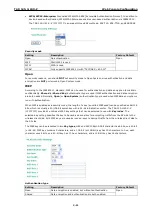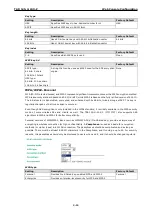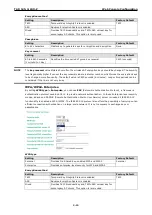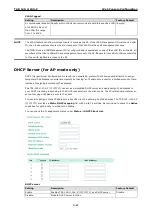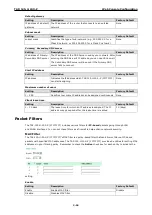
TAP-125-U-W-X-Z
(YYYYYYYY)
Web Console Configuration
3-22
Write community (for V1, V2c)
Setting
Description
Factory Default
V1, V2c Read /Write
Community
Use a community string match with a maximum of 31
characters for authentication. This means that the SNMP agent
can accesses all objects with read/write permissions using this
community string.
private
SNMP agent version
Setting
Description
Factory Default
V1, V2c, V3, or
V1, V2c, or V3 only
Select the SNMP protocol version used to manage the switch. V1, V2c
Admin auth type (for V1, V2c, V3, and V3 only)
Setting
Description
Factory Default
No Auth
Use admin account to access objects. No authentication
No Auth
MD5
Provide authentication based on the HMAC-MD5 algorithms.
8-character passwords are the minimum requirement for
authentication.
SHA
Provides authentication based on
HMAC-SHA algorithms. 8-character passwords are the
minimum requirement for authentication.
Admin private key (for V1, V2c, V3, and V3 only)
Setting
Description
Factory Default
Disable
No data encryption
Disable
DES
DES-based data encryption
AES
AES-based data encryption
Private key
A data encryption key is the minimum requirement for data encryption (maximum of 63 characters)
Private MIB Information Device Object ID
Also known as OID. This is the TAP-125-U-W-X-Z (YYYYYYYY)’s enterprise value. It is fixed.
Auto Warning Settings
Since industrial-grade devices are often located at the endpoints of a system, these devices will not always
know what is happening elsewhere on the network. This means that these devices, including wireless APs or
clients, must provide system maintainers with real-time alarm messages. Even when system administrators
are out of the control room for an extended period, they can still be informed of the status of devices almost
instantaneously when exceptions occur.
In addition to logging these events, the TAP-125-U-W-X-Z (YYYYYYYY) supports different approaches to
warn engineers automatically, such as SNMP trap, e-mail, and relay output. It also supports two digital
inputs to integrate sensors into your system to automate alarms by email and relay output.




